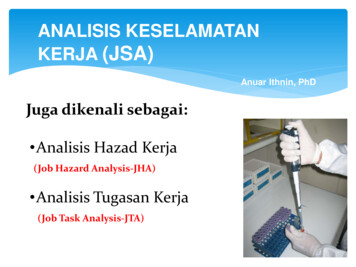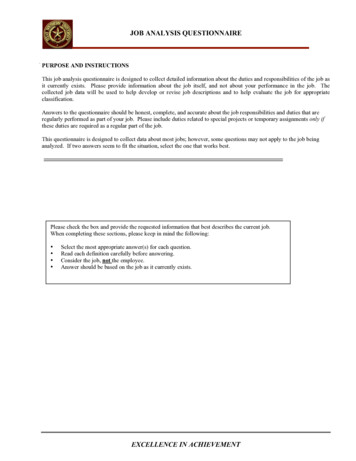
Transcription
IJSTE - International Journal of Science Technology & Engineering Volume 3 Issue 08 February 2017ISSN (online): 2349-784XJob Safety Analysis (JSA) with Risk Assessment inWelding of TLB Dipper by Tack WeldingDhiraj Kumar BarpeteM. Tech. StudentDepartment of Fire Technology & Safety EngineeringS.K.S.I.T.S, Indore (M.P), IndiaVivek ShuklaAssistant ProfessorDepartment of Fire Technology & Safety EngineeringS.K.S.I.T.S, Indore (M.P), IndiaDr. G.D GidwaniProfessor & Executive DirectorDepartment of Fire Technology & Safety EngineeringS.K.S.I.T.S, Indore (M.P), IndiaAbstractIndustrial accidents and disease remain the most terrible human tragedy of modern industry and one of its most serious forms ofeconomic waste. Not only direct but also indirect costs of accidents are tremendously increasing and causing the great nationalloss. This can be prevented by safety only. As productivity of any organization is interrelated with safety, means increasing andmaintaining safety gives good productivity. But due to lack of inspection, supervision and training for safely and no written rulesfor job description, procedure and safe production from management are the main factors which impending safety. The use ofrisk assessment methodologies contributes to prevent and control undesired event i.e. near miss or accident.Keywords: Job Safety Analysis, Risk Analysis, Risk AssessmentI.INTRODUCTIONHazard identification and risk assessment is systematic process to protect the health and minimize danger to life of workers,property and environment. It includes the methodological steps to identify hazard related to materials, operations and workplaceconditions. In this assess the risk level and applying the possible remedies and corrective actions to reduce the risk.As the part ofthe project work, hazard identification and risk analysis was carried out in a dipper tack welding process in constructionequipment manufacturing industry. In this the risk level is divided into very high, high, medium and low depending upon theirconsequences and likelihood of hazards and severity. The very high and high risks activities have been marked in red color anddark yellow respectively these are un-acceptance and must be reduced. The risks which are marked in yellow color are tolerablebut efforts must be made to reduce risk. The risks which are marked in green have the risk level so low that it is not required fortaking actions to reduce its magnitude any further.II. METHODOLOGYRisk is the results from hazard i.e. an unsafe condition, unsafe action or situation. Risk is the probability of frequency of hazardsduring a certain period. Therefore, if hazard is identified and removed first, risk is automatically reduced.Some definitions are asunder:HazardIt is the inherent property of a substance or unsafe condition, unsafe action or situation to cause harm which may cause humaninjury, damage to property or the environment or some combination of these criteria [2].RiskIt is the likelihood, chance, frequency or probability of an undesired event (i.e. accident, injury or death) occurring within aspecified period or under specified circumstances and its gravity (severity), effect or consequences [2].Risk AnalysisTechnical process of identifying, understanding and evaluating risk (analyzing cause and effect wise) [2].All rights reserved by www.ijste.org67
Job Safety Analysis (JSA) with Risk Assessment in Welding of TLB Dipper by Tack Welding(IJSTE/ Volume 3 / Issue 08 / 012)Risk AssessmentIt is a judgment of significance or activities that enable to identify, evaluate and measure risk and uncertainty and their potentialimpact.Job Safety AnalysisJob Safety Analysis is a termed as ‘JSA’ and it is defined as the procedure of analyzing the job for the purpose of finding hazardsin each steps and developing the safety precautions to be adopted.This JSA technique can be applied at any stages of process activities and it is the most useful at the stage of planning, designand starting of process [2].Risk CalculationRisk terms states that “It is the possibility of a certain undesired event occurring within a identified period such that individual orothers may be expected to sustain a given level of harm from the realization of specific hazards” [2].Formula for risk calculation asR PXGWhere,R Total Risk.P Probability of occurrence of event.G Severity (Gravity or degree of harm)Here,Probability (P) asP 1; Very Low Probability to Occur (Event almost not possible to occur)P 2; Lower Probability to Occur (Probability 1 / year)P 3; Probable to Occur (Probability 1 month)P 4; Highly Probability to Occur (Risk Probability always exist)Now,Gravity (G) asG 1; First AidG 2; Minor Accident (Lost Time up to 3 days)G 3; Major Accident (Lost Time 3 & 30 days)G 4; Serious Injury, Fatal (Lost Time 30, fatal)Standard Risk MatrixFig. 1: Standard Risk MatrixClassification Risk Levels and their Color CodesRisk levels and their color codes are classified into 4 levels on the basis of their score or calculation they are as shown below:1) Very High Risk Level, Red2) High Risk Level, Orange3) Medium or Moderate Risk Level, Yellow4) Low Risk Level, GreenFig. 2: Classification of Risk level with color codes.All rights reserved by www.ijste.org68
Job Safety Analysis (JSA) with Risk Assessment in Welding of TLB Dipper by Tack Welding(IJSTE/ Volume 3 / Issue 08 / 012) Very high risk: Not acceptable: The risk is not acceptable and must strongly attached. There is needed to implementimmediate countermeasures in order to reduce the level of the risk at least to a tolerable level.High risk: Improvable: The risk is not acceptable and must be improvable. There is needed to implement rapidcountermeasures in order to reduce the level of the risk at least to a tolerable level.Medium risk: Tolerable: The risk is tolerable. There is needed to evaluate possible countermeasures in order to reduce thelevel of the risk to an acceptable level. Continuous improvement approach is required.Low risk: Acceptable: The risk is acceptable. Continuous monitoring about safety conditions is required.Countermeasures or ControlWhen determining controls and considering changes to existing control, consideration shall be given to reducing the risksaccording to the following hierarchy [5]: Elimination Substitution Engineering controls Signage / warnings and administrative control Personal Protective EquipmentMethodology ProcessA method includes the following steps for the routine work i.e. the work which relates to the production unit:1) Selection of the job2) Divide the job into number of task3) Notice the hazards associated with each task separately4) Analysis the risk5) Score the risk from standard risk matrix6) Prioritize the risk7) Firstly take action on the very high, high, medium risk level and further on low risk level8) Provide effective countermeasures or control to reduce risk levels such that try to bring the risk to the tolerable limit i.e. lowrisk level9) Again score the risk.Fig. 3: Basic Flow Chart of JSA with Risk Assessment process.All rights reserved by www.ijste.org69
Job Safety Analysis (JSA) with Risk Assessment in Welding of TLB Dipper by Tack Welding(IJSTE/ Volume 3 / Issue 08 / 012)Now we have considering tasks in DipperTack Welding Operation in Fabrication process they are infollowing waysTask 1: Fitting of Boss sub assembly on bucket end side of dipper: In this task operator has to lift the boss sub assemblymanually by hand which has the weight of 15.6 KG from tode bin box. Thus, hazards are of fall of material, andergonomics problem of excessive bending and , fracture injury may could be occur Task 2: Positioning of Dipper Box on Fixture: In this task operator has to lift the dipper box through simply fixing of hookwithout latches (locking hook) and no lifting tackle for dipper box. Thus, thereare a more chances of fall of dipper box fromhook which could cause any major injury to operator. Task 3: Fitting of Bosses in dipper: In this task, operator has to go for picking up the boss from the bin which has weight of8 KG and cylindrical shape boss could be slip from his hands. Thus, operation involving of excessive forces which causestrain on hand and waist. Task 4: Mounting of Nav sub assembly: In this task no lifting tackle available to lift effectively the nav sub assembly, sothey lift by hand which having the sharp edges on corners. Thus, there may be chances of cut injury and fall of component. Task 5: Dipper side plate fitting: No lifting tackle available to lift side plate of dipper from bin. Thus, operator has to bendmore which involve more bending of waist could causes strain on waist and in hand. Task 6: Fitting of rocket sub assembly: In this task no lifting tackle available to lift effectively the rocket sub assembly, sothey lift by hand which having the sharp edges, Thus, there may be chances of cut injury and fall of component. Task 7: Start of Tack welding: Fixture or manipulator having the hydraulic based system pipes for tightening and fix abovemention parts in their location which are in open condition. There could be forcefully leakage of hot oil from hoses if anycomponent falls on it which may lead any to any serious injury. Secondly, during welding operation, no proper platform forworking as operator has to stand on fixture platform and no fumes extractor found on work station to extract out harmfulgases. Glare which comes when the arc is struck, heat radiation from welding can cause headache, fatigue, eye damage andburn injury. Task 8: Unloading the dipper: After the welding operation, next task is to unload the dipper from manipulator. As no theirno lifting tackle found so operator fix the hook and sling around the dipper and lift it above the operators height. Thus, inthis task there will be chances of burn injury and fall of component which leads to any major injury.Safety risk assessment of dipper tack welding workplace on basis of above mentioned tasks and movement of operator asshown in table below: Station no.Taskno.11111111111111111111111112Table – 1Safety Risk Assessment for Dipper Tack Welding StationSafety Risk Assessment- Dipper Tack WeldingBefore RiskUnsafe Condition (Hazard)Risk DescriptionPGRPresence of compressed airEye injury due to Particle326blow, spatterspenetrationPresence of abrasive materialBody injury on account of212in work placeabrasion/scratchBody injury due toMachine/tool/parts notHit/Impact/Crush from313properly arrangedmachine/tools/partsPresence of sharp objects atCut injury due to penetration of313work placesharp objectsPresence of unevensurfaces/holes/openings onBody injury due to fall224floor in work areaUse of improper tools e.g.hammers mushroomed, bentBody injury326etc.Inadequate free space inBody injury due to hit/collision313walkways/aislesUnavailability of emergencyInjury due to collision/communication signs (exits,stampede during emergency224evac, fire exits etc.)evacuationUnavailability of properhooks, Tackle & fixtures forBody injury due to fall of parts4312lifting partsAbsence of signs/instructionBody injury due to non usage of133to wear PPEs at work stationPPEsPPEs not inspected regularlyBody injury due to failure of133and not in good conditionPPEOperation requiring reachingFatigue/ body strain428below waistPresence of abrasive materialBody injury on account of212CountermeasureDescriptionProvision of Weldingshield & GoggleAfter RiskP G R313Use of PPE212Workplace organization111Use of Hand Gloves212Repairing of Floor111Provision of Hammer1115S Required111Provision of emergencysigns111Lifting Tackle for Dipperboss s/a144PPE Requirements posted122122111212Operators trained on careof PPEProvision of Dipper bosss/a trolleyUse of PPEAll rights reserved by www.ijste.org70
Job Safety Analysis (JSA) with Risk Assessment in Welding of TLB Dipper by Tack Welding(IJSTE/ Volume 3 / Issue 08 / 012)in work placeMachine/tool/parts notproperly arranged1212121212121212121313131313Hoists, cranes, ropes, chainsnot maintained properly13Hoists & lifting devices notmarked with capacity131313131414141414Presence of sharp objects atwork placePresence of unevensurfaces/holes/openings onfloor in work areaSpillage of oils/nut & bolts,Presence of cables/hoses etc.on floorInadequate free space inwalkways/aislesUnavailability of emergencycommunication signs (exits,evac, fire exits etc.)Unavailability of properhooks, Tackle & fixtures forlifting partsAbsence of signs/instructionto wear PPEs at work stationPPEs not inspected regularlyand not in good conditionMachine/tool/parts notproperly arrangedSpillage of oils/nut & bolts,Presence of cables/hoses etc.on floorInadequate free space inwalkways/aislesUnavailability of emergencycommunication signs (exits,evac, fire exits etc.)Unavailability of properhooks, Tackle & fixtures forlifting partsAbsence of signs/instructionto wear PPEs at work stationPPEs not inspected regularlyand not in good conditionOperation involves awkwardrepetitive motionsPresence of abrasive materialin work placeMachine/tool/parts notproperly arrangedPresence of sharp objects atwork placePresence of unevensurfaces/holes/openings onfloor in work areaSpillage of oils/nut & bolts,Presence of cables/hoses etc.on floorabrasion/scratchBody injury due toHit/Impact/Crush frommachine/tools/partsCut injury due to penetration ofsharp objects313Workplace organization111313Use of Hand Gloves212Body injury due to fall224Repairing of Floor111Body injury due to slip326Provision of Tray belowthe fixture212Body injury due to hit/collision3135S Required111Injury due to collision/stampede during emergencyevacuation224Provision of emergencysigns111Body injury due to fall of parts4312Lifting Tackle for Dipperbox133133PPE Requirements posted122133Operators trained on careof PPE122313Workplace organization111Body injury due to slip326Provision of Tray212Body injury due to hit/collision3135S Required111224Provision of emergencysigns111144Ma
Job Safety Analysis (JSA) with Risk Assessment in Welding of TLB Dipper by Tack Welding (IJSTE/ Volume 3 / Issue 08 / 012) All rights reserved by www.ijste.org 68 Risk Assessment It is a judgment of significance or activities that enable to identify, evaluate and measure risk and uncertainty and their potential impact. Job Safety Analysis










